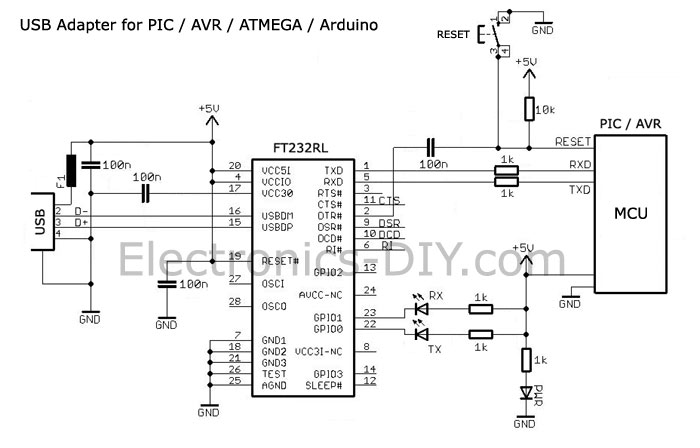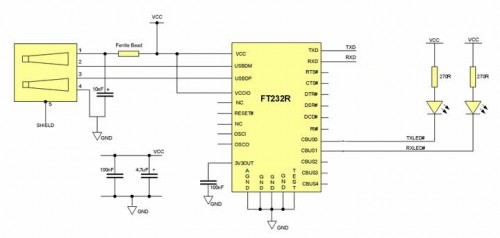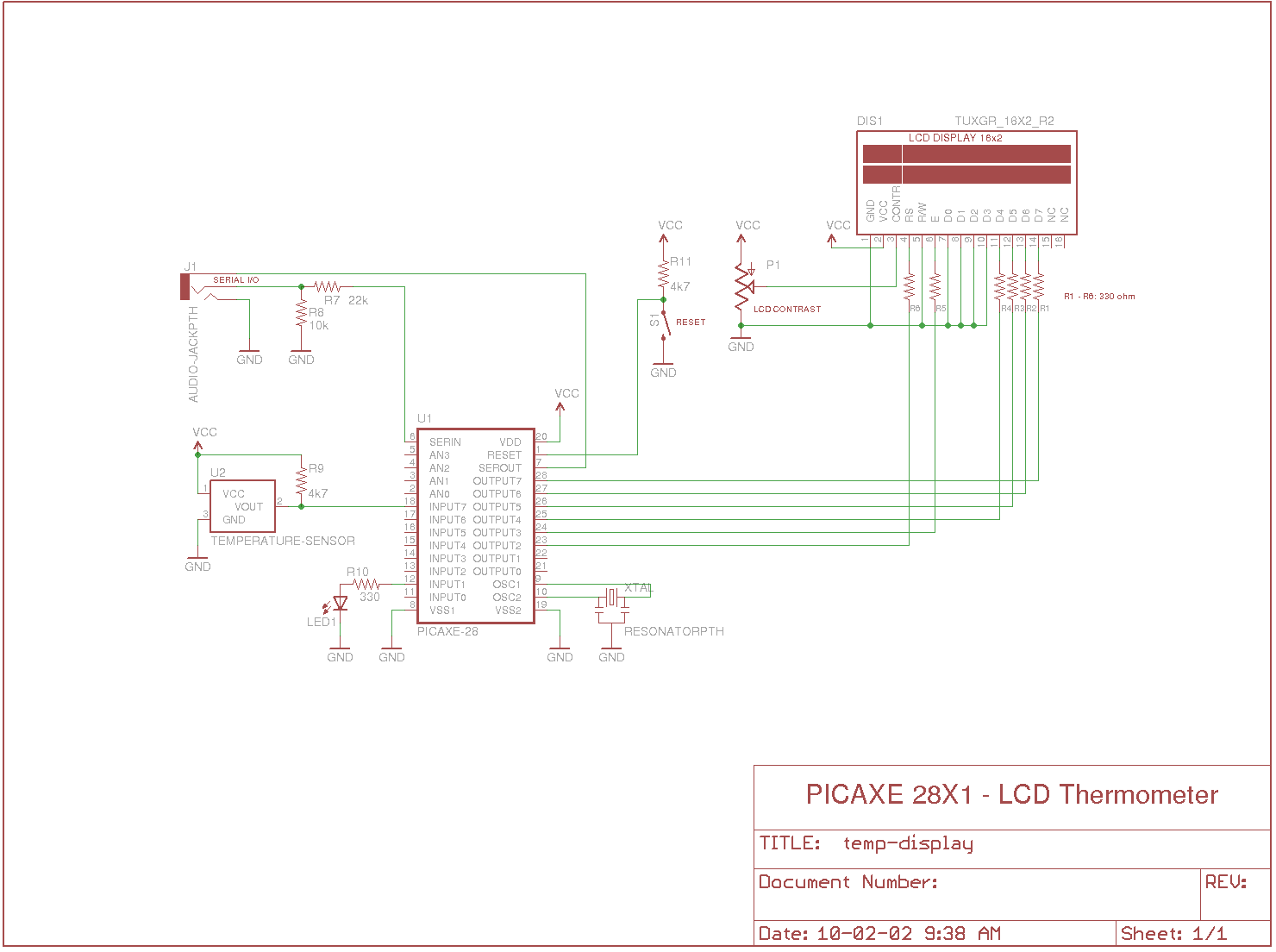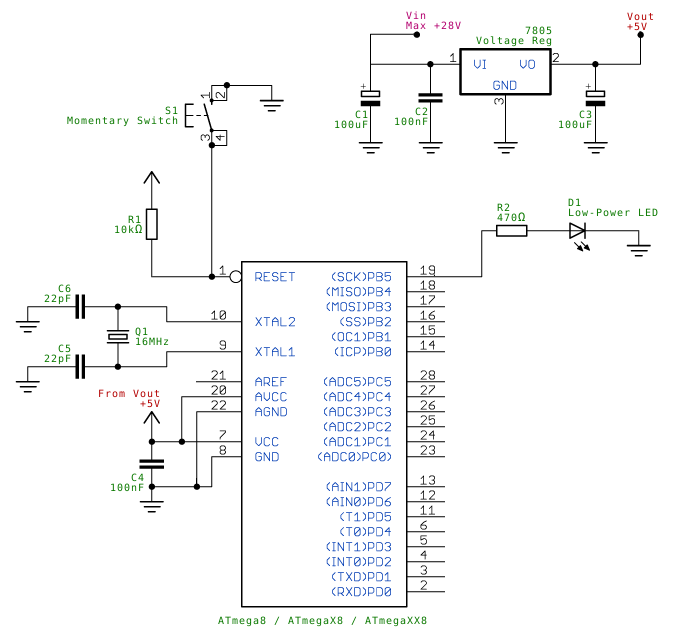
FT232RL USB to Serial Adapter for PIC AVR ATMEGA ARDUINO MCUs

The FT232RL USB to Serial UART (TTL) Adapter is an affordable and straightforward solution for connecting PIC, AVR, or ATMEGA microcontrollers to a PC or Mac via a USB interface. The FT232RL chip is noteworthy for its compliance with the full USB 2.0 protocol, eliminating the need for an external crystal, and featuring integrated EEPROM for device identification and product description strings, along with a royalty-free driver. It supports various operating systems, including Windows, Linux, and Mac OSX. The FT232RL offers two data lines, RXD and TXD, which connect through 1K resistors to microcontrollers such as PIC, AVR, ATMEGA, or ARDUINO. The USB port can provide up to 500mA of +5V power, which can be utilized to power both the FT232RL chip and the connected MCU. When interfaced with a PC, the FT232RL appears as a Virtual COM port in the Device Manager, facilitating easy data transmission and reception with PIC, AVR, or ATMEGA microcontrollers. The FT232R introduces two new functionalities compared to its predecessors, effectively functioning as a "3-in-1" chip for certain applications. The internally generated clock (available at 6MHz, 12MHz, 24MHz, and 48MHz) can be utilized to drive a microcontroller or external logic. Each device has a unique identifier (FTDIChip-ID) programmed during manufacturing, which can be accessed via USB, serving as a security feature to protect application software from unauthorized duplication.
The integrated clock circuit in the FT232R eliminates the need for an external crystal or ceramic resonator, although an external 12MHz crystal can still be used if desired. The integrated EEPROM allows for customization of USB Vendor ID (VID), Product ID (PID), serial number, and product description strings without requiring an external EEPROM, providing flexibility in design. The internal EEPROM is programmable in-circuit over USB without additional voltage requirements. The FT232R comes with the internal EEPROM pre-programmed with a unique serial number for each device, often negating the need for user programming.
Moreover, the FT232R integrates USB resistors that were previously external, thereby simplifying the design. The AVCC filtering has also been integrated, removing the need for an external R-C filter. The overall integration of these components significantly reduces the bill of materials for USB interface designs utilizing the FT232R compared to the FT232BM.
The FT232R features five configurable Control Bus (CBUS) lines, which can be assigned various functions, including TXDEN (transmit enable for RS485 designs), PWREN# (power control for high power, bus-powered designs), TXLED# and RXLED# (for LED indication during data transmission and reception), or a combined TX&RXLED#. Additional options include SLEEP# (indicating USB suspend mode) and clock output signals (CLK48, CLK24, CLK12, CLK6). The CBUS lines can be configured to support bit-banging operations, enhancing the versatility of the FT232R in various applications.FT232RL USB to Serial UART (TTL) Adapter is a simple and inexpensive way to connect PIC, AVR or ATMEGA MCUs to a PC or Mac via USB connection. FT232RL is an impressive chip because it implements full v2. 0 USB protocol, needs no external crystal, has integrated EEPROM for device ID and product description strings and comes with Royalty-Free driver
support for Windows, Linux, and Mac OSX. FT232RL chip provides two data lines RXD and TXD that are connected through 1K resistors to a microcontroller such as PIC AVR ATMEGA ARDUINO. Up to 500mA of +5V power can be obtained from USB port and used to power both FT232RL chip and your favourite MCU.
When connected to a PC FT232RL is mounted and shows as Virtual COM port in Device Manager making it easy to send and receive data from PIC, AVR or ATMEGA microcontrollers. The FT232R adds two new functions compared with its predecessors, effectively making it a "3-in-1" chip for some application areas.
The internally generated clock (6MHz, 12MHz, 24MHz, and 48MHz) can be brought out of the device and used to drive a microcontroller or external logic. A unique number (the FTDIChip-ID) is burnt into the device during manufacture and is readable over USB, thus forming the basis of a security dongle which can be used to protect customer application software from being copied.
Integrated Clock Circuit - Previous generations of FTDI`s USB UART devices required an external crystal or ceramic resonator. The clock circuit has now been integrated onto the device meaning that no crystal or ceramic resonator is required.
However, if preferred, an external 12MHz crystal can be used as the clock source. Integrated EEPROM - Previous generations of FTDI`s USB UART devices required an external EEPROM if the device were to use USB Vendor ID (VID), Product ID (PID), serial number and product description strings other than the default values in the device itself. This external EEPROM has now been integrated onto the FT232R chip meaning that all designs have the option to change the product description strings.
A user area of the internal EEPROM is available for storing additional data. The internal EEPROM is programmable in circuit, over USB without any additional voltage requirement. Preprogrammed EEPROM - The FT232R is supplied with its internal EEPROM pre-programmed with a serial number which is unique to each individual device. This, in most cases, will remove the need to program the device EEPROM. Integrated USB Resistors - Previous generations of FTDI`s USB UART devices required two external series resistors on the USBDP and USBDM lines, and a 1.
5 k © pull up resistor on USBDP. These three resistors have now been integrated onto the device. Integrated AVCC Filtering - Previous generations of FTDI`s USB UART devices had a separate AVCC pin the supply to the internal PLL. This pin required an external R-C filter. The separate AVCC pin is now connected internally to VCC, and the filter has now been integrated onto the chip.
Less External Components - Integration of the crystal, EEPROM, USB resistors, and AVCC filter will substantially reduce the bill of materials cost for USB interface designs using the FT232R compared to its FT232BM predecessor. Configurable CBUS I/O Pin Options - There are now 5 configurable Control Bus (CBUS) lines. Options are TXDEN - transmit enable for RS485 designs, PWREN# - Power control for high power, bus powered designs, TXLED# - for pulsing an LED upon transmission of data, RXLED# - for pulsing an LED upon receiving data, TX&RXLED# - which will pulse an LED upon transmission OR reception of data, SLEEP# - indicates that the device going into USB suspend mode, CLK48 / CLK24 / CLK12 / CLK6 - 48MHz, 24MHz, 12MHz, and 6MHz clock output signal options.
There is also the option to bring out bit bang mode read and write strobes (see below). The CBUS lines can be configured with any one of these output options by setting bi 🔗 External reference
The integrated clock circuit in the FT232R eliminates the need for an external crystal or ceramic resonator, although an external 12MHz crystal can still be used if desired. The integrated EEPROM allows for customization of USB Vendor ID (VID), Product ID (PID), serial number, and product description strings without requiring an external EEPROM, providing flexibility in design. The internal EEPROM is programmable in-circuit over USB without additional voltage requirements. The FT232R comes with the internal EEPROM pre-programmed with a unique serial number for each device, often negating the need for user programming.
Moreover, the FT232R integrates USB resistors that were previously external, thereby simplifying the design. The AVCC filtering has also been integrated, removing the need for an external R-C filter. The overall integration of these components significantly reduces the bill of materials for USB interface designs utilizing the FT232R compared to the FT232BM.
The FT232R features five configurable Control Bus (CBUS) lines, which can be assigned various functions, including TXDEN (transmit enable for RS485 designs), PWREN# (power control for high power, bus-powered designs), TXLED# and RXLED# (for LED indication during data transmission and reception), or a combined TX&RXLED#. Additional options include SLEEP# (indicating USB suspend mode) and clock output signals (CLK48, CLK24, CLK12, CLK6). The CBUS lines can be configured to support bit-banging operations, enhancing the versatility of the FT232R in various applications.FT232RL USB to Serial UART (TTL) Adapter is a simple and inexpensive way to connect PIC, AVR or ATMEGA MCUs to a PC or Mac via USB connection. FT232RL is an impressive chip because it implements full v2. 0 USB protocol, needs no external crystal, has integrated EEPROM for device ID and product description strings and comes with Royalty-Free driver
support for Windows, Linux, and Mac OSX. FT232RL chip provides two data lines RXD and TXD that are connected through 1K resistors to a microcontroller such as PIC AVR ATMEGA ARDUINO. Up to 500mA of +5V power can be obtained from USB port and used to power both FT232RL chip and your favourite MCU.
When connected to a PC FT232RL is mounted and shows as Virtual COM port in Device Manager making it easy to send and receive data from PIC, AVR or ATMEGA microcontrollers. The FT232R adds two new functions compared with its predecessors, effectively making it a "3-in-1" chip for some application areas.
The internally generated clock (6MHz, 12MHz, 24MHz, and 48MHz) can be brought out of the device and used to drive a microcontroller or external logic. A unique number (the FTDIChip-ID) is burnt into the device during manufacture and is readable over USB, thus forming the basis of a security dongle which can be used to protect customer application software from being copied.
Integrated Clock Circuit - Previous generations of FTDI`s USB UART devices required an external crystal or ceramic resonator. The clock circuit has now been integrated onto the device meaning that no crystal or ceramic resonator is required.
However, if preferred, an external 12MHz crystal can be used as the clock source. Integrated EEPROM - Previous generations of FTDI`s USB UART devices required an external EEPROM if the device were to use USB Vendor ID (VID), Product ID (PID), serial number and product description strings other than the default values in the device itself. This external EEPROM has now been integrated onto the FT232R chip meaning that all designs have the option to change the product description strings.
A user area of the internal EEPROM is available for storing additional data. The internal EEPROM is programmable in circuit, over USB without any additional voltage requirement. Preprogrammed EEPROM - The FT232R is supplied with its internal EEPROM pre-programmed with a serial number which is unique to each individual device. This, in most cases, will remove the need to program the device EEPROM. Integrated USB Resistors - Previous generations of FTDI`s USB UART devices required two external series resistors on the USBDP and USBDM lines, and a 1.
5 k © pull up resistor on USBDP. These three resistors have now been integrated onto the device. Integrated AVCC Filtering - Previous generations of FTDI`s USB UART devices had a separate AVCC pin the supply to the internal PLL. This pin required an external R-C filter. The separate AVCC pin is now connected internally to VCC, and the filter has now been integrated onto the chip.
Less External Components - Integration of the crystal, EEPROM, USB resistors, and AVCC filter will substantially reduce the bill of materials cost for USB interface designs using the FT232R compared to its FT232BM predecessor. Configurable CBUS I/O Pin Options - There are now 5 configurable Control Bus (CBUS) lines. Options are TXDEN - transmit enable for RS485 designs, PWREN# - Power control for high power, bus powered designs, TXLED# - for pulsing an LED upon transmission of data, RXLED# - for pulsing an LED upon receiving data, TX&RXLED# - which will pulse an LED upon transmission OR reception of data, SLEEP# - indicates that the device going into USB suspend mode, CLK48 / CLK24 / CLK12 / CLK6 - 48MHz, 24MHz, 12MHz, and 6MHz clock output signal options.
There is also the option to bring out bit bang mode read and write strobes (see below). The CBUS lines can be configured with any one of these output options by setting bi 🔗 External reference





